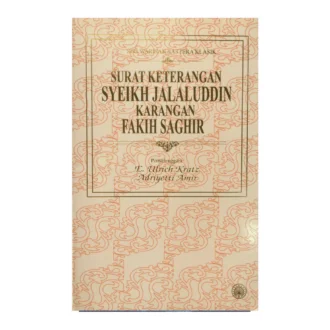Rumah: An Ode to the Malay House is a collection of old Riau–Malay rhymed sayings originally gathered and published by Tenas Effendy. Referred to in Malay literature as ‘Ungkapan’, these eloquent stanzas depict the Malay house as a metaphor for the passage of life, the responsibilities of parenthood, the social observances of communal living, and the obligations of existing harmoniously with nature. Together, they form a complex work that vividly illustrates the values of customary law, etiquette, cultural protocols and religious tenets as cherished within a Malay home. The sayings themselves beautifully capture and radiate the warmth of a graceful Malay kampung house cast within the idyllic setting of a lush tropical oasis. Rumah has been elegantly translated by Raimy Ché-Ross and richly illustrated by Ahmad Harun.
“Peruse RUMAH and appreciate the thousand and one meanings within its pages…” — Lat Tenas Effendy once said that a house should not only be a place to live in, but it should also exemplify the perfection of life. The traditional Riau–Malay house, as eloquently expressed by him in this poem, represents these tender aspirations: the imparting of traditional mores and customs from wise elders to the young, the demarcation and respect for living spaces, the obligations owed by parents towards the education of their children within the safe, nurturing confines of a home, and the bonds of communal living within an agrarian society.
Above all, the physical structure of a Riau–Malay house is a tangible manifestation and constant symbol of our place in both the temporal and spiritual realms. Through his poetic presentation of these ancient pearls of wisdom, Tenas Effendy reminds us that only by truly understanding the deeper meanings behind the symbols and nuances so lovingly crafted into its surface can we appreciate the Riau–Malay house as a timeless, living home.
Firstly, Rumah: An Ode to the Malay House discusses the Malay house as a cultural artefact and reminds us of a traditional way of life that is rapidly disappearing. It is a way of life that may still be glimpsed in films from the 1950s. Many of today’s youth, born and bred in the city mostly in high-rise apartments, in contemporary bungalows and terrace houses are not fully conversant with the ethos and the values of the village way of life in times gone by. But it is after all such values that makes us culturally different. Secondly the poem is important for all as it articulates the significance of the Malay house as a cultural icon.
For the architect, the Malay house is the classic house design prototype for the hot, humid tropical climate of Malaysia. Its built form features, such as a steep pitched roof for the rapid removal of torrential rain, a Hoor raised above ground with the floor boards paced slightly apart to let the ventilation through, and the multi-layered fenestration (comprising an inner layer of curtains for privacy, the balustrade layer for safety and the outer operable louvred windows) might, in aggregate, be regarded as an intuitive precedent to today’s high-tech double-skin façade in high-rise towers.
The organisation of spaces within the house is of course particular to its way of life. A key spatial feature is the front terrace (the ‘serambi’) which is the transitional interstitial zone between the inside and the outside, one that serves as a crucial social interactive space between the house dwellers and village community.











Nor aslaini Mohd nasir (Verified Reader) –